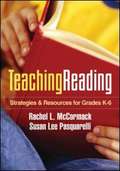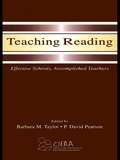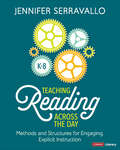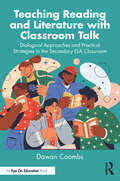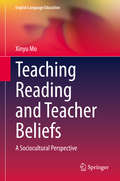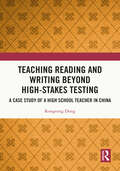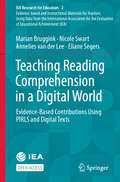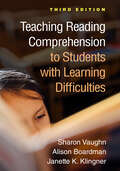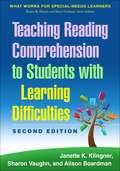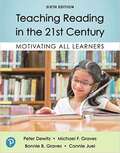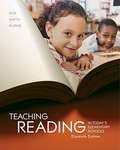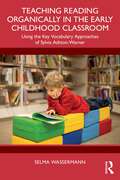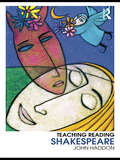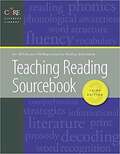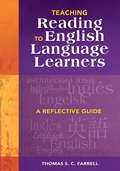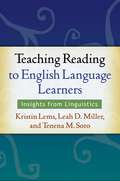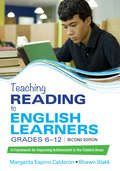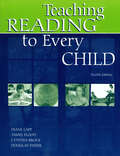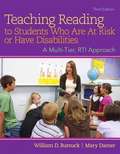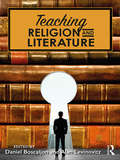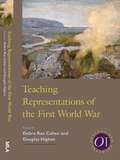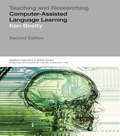- Table View
- List View
Teaching Reading: Strategies and Resources for Grades K-6
by Rachel L Mccormack Susan Lee PasquarelliElementary teachers of reading have one essential goal—to prepare diverse children to be independent, strategic readers in real life. This innovative text helps preservice and inservice teachers achieve this goal by providing knowledge and research-based strategies for teaching phonemic awareness, phonics, fluency, vocabulary, all aspects of comprehension, and writing in response to literature. Special features include sample lessons and photographs of literacy-rich classrooms. Uniquely interactive, the text is complete with pencil-and-paper exercises and reproducibles that facilitate learning, making it ideal for course use. Readers are invited to respond to reflection questions, design lessons, and start constructing a professional teaching portfolio.
Teaching Reading: Effective Schools, Accomplished Teachers
by Barbara M. Taylor P. David PearsonThis unique book tells the story of a select group of schools and teachers who have managed to beat the odds in terms of improving elementary students reading achievement. Originating with the CIERA School Change Project directed by Barbara Taylor and David Pearson, it was subsequently expanded to include the work of other research teams doing similar work. It combines large scale studies of effective schools and teachers (Part I) with case studies of individual schools and teachers who have successfully transformed research findings into situation-specific strategies appropriate to their schools and classrooms (Parts II and III). The book's distinct contribution is showing that no matter how consistent the research findings on effective school and classroom practice, groups of teachers must improvise their own situation-specific programs and practices. In short, they must be able to create variations on a common theme. Key features of this outstanding new volume include: *Integration of research and cases--One cannot fully understand research-based general principles without knowing how they play themselves out in specific settings. Similarly, one cannot fully understand cases without seeing the commonalities across different schools and classrooms sharing similar goals. This book provides both perspectives. *Diverse cases--The schools and classrooms depicted in this book are urban, rural, and suburban; poor and middle class; and English-only and bilingual. Rather than telling readers how to beat the odds, it provides them with a wide variety of cases from which they can extrapolate to build their own customized teaching programs and practices. *Summarizing section--The final section contains a summary of research on effective schools and teachers and a concluding chapter by Gerry Duffy and Jim Hoffman in which they reflect on the book's content and possible directions for future research. The book is targeted to both in-service elementary teachers and literacy students in advanced college courses.
Teaching Reading Across the Day, Grades K-8: Methods and Structures for Engaging, Explicit Instruction
by Jennifer Serravallo"Reading well across disciplines and within varied contexts will help students to be versatile, flexible, deep readers who can better learn from their reading, transfer skills across subjects, and use strategies to meet the unique demands of reading in each content area." – Jennifer Serravallo Research-based, easy-to-use lesson structures for explicit and engaging teaching In Teaching Reading Across the Day, literacy expert Jennifer Serravallo provides nine effective, predictable, research-based lesson structures that help busy teachers save planning time and focus their teaching—and student attention—on content rather than procedures. Each of the nine lesson structures (read aloud, phonics and spelling, vocabulary, focus, shared reading, close reading, guided inquiry, reader’s theater, and conversation) has its own chapter and features a wealth of resources that let you see the lessons in action in ELA, Science, and Social Studies classes, including: An annotated teaching vignette, lesson explanation, and research notes Tips for planning, structure and timing suggestions, and ideas for responsive teaching Detailed planning templates and 22 accompanying online videos covering over 3 hours of classroom footage Jen’s reflections, key look-fors, and ideas for next steps The nine lesson structures can be used with any curriculum or core program, text, and subject, making it easier for teachers to maximize explicit and engaging teaching time across the day, and simplify planning and preparation. Jen incorporates a wide range of compelling research about how best to teach reading to every student in your class and translates the research (or the science of teaching reading) into high-leverage moves you can count on to deliver powerful lessons again and again. She also honors the art of teaching reading, helping teachers tap into their experience and hone their expertise to make quick, effective classroom decisions that take student learning to the next level.
Teaching Reading Across the Day, Grades K-8: Methods and Structures for Engaging, Explicit Instruction
by Jennifer Serravallo"Reading well across disciplines and within varied contexts will help students to be versatile, flexible, deep readers who can better learn from their reading, transfer skills across subjects, and use strategies to meet the unique demands of reading in each content area." – Jennifer Serravallo Research-based, easy-to-use lesson structures for explicit and engaging teaching In Teaching Reading Across the Day, literacy expert Jennifer Serravallo provides nine effective, predictable, research-based lesson structures that help busy teachers save planning time and focus their teaching—and student attention—on content rather than procedures. Each of the nine lesson structures (read aloud, phonics and spelling, vocabulary, focus, shared reading, close reading, guided inquiry, reader’s theater, and conversation) has its own chapter and features a wealth of resources that let you see the lessons in action in ELA, Science, and Social Studies classes, including: An annotated teaching vignette, lesson explanation, and research notes Tips for planning, structure and timing suggestions, and ideas for responsive teaching Detailed planning templates and 22 accompanying online videos covering over 3 hours of classroom footage Jen’s reflections, key look-fors, and ideas for next steps The nine lesson structures can be used with any curriculum or core program, text, and subject, making it easier for teachers to maximize explicit and engaging teaching time across the day, and simplify planning and preparation. Jen incorporates a wide range of compelling research about how best to teach reading to every student in your class and translates the research (or the science of teaching reading) into high-leverage moves you can count on to deliver powerful lessons again and again. She also honors the art of teaching reading, helping teachers tap into their experience and hone their expertise to make quick, effective classroom decisions that take student learning to the next level.
Teaching Reading and Literature with Classroom Talk: Dialogical Approaches and Practical Strategies in the Secondary ELA Classroom
by Dawan CoombsThis book presents a framework for conceptualizing and enacting dialogic approaches to teaching literature and reading in your classroom. Dialogical approaches have often been used in secondary classrooms for teaching writing by incorporating students’ lives and experiences into the English Language Arts (ELA) curriculum. But what might it look like to create reading moments that bring texts to life by allowing students to use their own identities and experiences as the foundation for their interpretation? The most current research in reading, motivation, culturally responsive teaching, and even neuroscience points to the power of dialogical approaches to not only engage students in reading texts, but—when used consistently and repeatedly—help increase students’ reading growth and achievement. Dialogical approaches can be particularly helpful for struggling readers, English language learners (ELLs), and neurodivergent students. This book explores dialogical approaches to teaching reading and literature in secondary ELA classrooms with descriptions of hands-on activities, models of dialogical strategies, and real-time examples from ELA and reading classes. Each chapter includes motivating, accessible, and research-based methods and tools that help students connect content to their lives and explore a diversity of perspectives. With resources such as assignment sheets and rubrics, this is an essential book for middle and high school ELA teachers, reading coaches and interventionists, teachers working with ELLs, and pre-service teachers who are looking to better understand and utilize dialogical approaches to support their students in transforming their reader identities.
Teaching Reading and Teacher Beliefs: A Sociocultural Perspective (English Language Education #20)
by Xinyu MoThis book explores language teacher beliefs in English as a Foreign Language (EFL) reading instruction in the context of Chinese university English instructors. Since the 1990s, there has been a renewed interest on teacher beliefs in the domain of language teacher cognition. However, most studies in this area aim at investigating the relationship between particular aspects of teacher beliefs and classroom practices, largely ignoring the complexity of teacher beliefs. This study explores the issue from an alternative perspective by conceptualizing teacher beliefs as a complex, dynamic and multi-faceted system. By adopting five rounds of interview and four classroom observations, the year-long study reveals seven key features of the belief system shared among six participants. It calls for the holistic, complex and insider view to examine teacher beliefs in relation to the sociocultural and historical contexts where the teachers work and live.
Teaching Reading and Writing Beyond High-stakes Testing: A Case Study of a High School Teacher in China
by Rongrong DongThis book tells about an exemplary high school Chinese language arts teacher’s effort in nurturing life-long readers and writers under the test-driven culture in China’s society. It looks closely at his everyday literacy practices, focuses on his ways of creating authentic reading and writing spaces for students beyond test preparation. With the lens of social constructivism, the case study reveals his efforts of creating safe learning environment, modeling his literate life, connecting real life with literacy learning and building a school-wide literate life for students. Furthermore, he also collaborates with other Chinese language arts faculty, reaches out to school administrators and educators to gain any potential teaching resource for students. The findings indicate exemplary teachers are not only equipped with professional knowledge but also inter/intrapersonal knowledge and practical knowledge in their teaching career, which might be enlightening in today’s high-stakes testing culture. The book will appeal to scholars of literacy education and teacher education, as well as pre-service & in-service teachers.
Teaching Reading Comprehension in a Digital World: Evidence-Based Contributions Using PIRLS and Digital Texts (IEA Research for Educators #2)
by Marian Bruggink Nicole Swart Annelies van der Lee Eliane SegersThis open access book helps teachers include the reading of digital texts in their curriculum. Using ePIRLS, it informs teachers about digital reading and evidence-based teaching principles for digital reading. This publication raises awareness about digital inclusion within schools and how this affects students’ opportunities to learn. This volume describes recent scientific insights regarding digital reading and emphasizes the importance of digital inclusion within schools. Evidence-based didactic guidelines for digital reading are described to help teachers learn more about supporting their students in reading digital texts. Using an ePIRLS text, it discusses the challenges students encounter in reading digital texts and concretizes the didactic suggestions. Additionally, good practices from PIRLS countries regarding digital reading are highlighted, which can be an inspiration to teachers across the world.
Teaching Reading Comprehension to Students with Learning Difficulties (The Guilford Series on Intensive Instruction)
by Sharon Vaughn Janette K. Klingner Alison BoardmanNow in a revised and expanded third edition, this important resource helps teachers understand how good readers comprehend text and how best to support students who are struggling. It presents effective instructional methods for learners at all grade levels, including those with reading disabilities. Every chapter translates state-of-the-art research into practical classroom applications. All facets of comprehension are addressed, including assessment, vocabulary, background knowledge, and text structure. Chapters also cover English learners, intensive intervention, and content literacy. Utility as a teacher guide and course text is enhanced by sample lesson plans, graphic organizers, and chapter-opening study questions. New to This Edition *Chapter on text selection and text structure. *Chapter on teachers' frequently asked questions, providing specific, actionable advice. *More than twice as many sample lesson plans. *Revised throughout with the latest research and teaching techniques.
Teaching Reading Comprehension to Students with Learning Difficulties, 2/E
by Alison Boardman Sharon Vaughn Janette K. KlingnerThis practitioner resource and course text has given thousands of K-12 teachers evidence-based tools for helping students--particularly those at risk for reading difficulties--understand and acquire new knowledge from text. The authors present a range of scientifically validated instructional techniques and activities, complete with helpful classroom examples and sample lessons. The book describes ways to assess comprehension, build the skills that good readers rely on, and teach students to use multiple comprehension strategies flexibly and effectively. Each chapter features thought-provoking discussion questions. Reproducible lesson plans and graphic organizers can be downloaded and printed in a convenient 8 1/2" x 11" size. New to This Edition *Chapters on content-area literacy, English language learners, and intensive interventions. *Incorporates current research on each component of reading comprehension. *Discusses ways to align instruction with the Common Core State Standards. *Additional instructional activities throughout.
Teaching Reading in the 21st Century: Motivating All Learners
by Peter Dewitz Michael Graves Bonnie Graves Connie JuelA student-centered focus on reading instruction that fosters students’ motivation and passion for reading. <p><p> Teaching Reading in the 21st Century: Motivating All Learners takes a student-centered approach to teaching reading, emphasizing motivation over efficiency in order to develop students who want to read, and therefore can read. Based on the most current research, this text covers the five major components of reading while constantly reinforcing the idea that motivation leads to students who read widely and deeply, allowing the students’ fluency, vocabulary, and comprehension to grow. <p><p> The 6th Edition has been extensively revised, with a new chapter (6) on selecting texts, significant updates to the topic of assessment, and an increased emphasis on digital texts and other online resources.
Teaching Reading in Today's Elementary Schools Eleventh Edition
by Betty D. Roe Sandy H. SmithThis market-leading text sets the standard for reading instruction to ensure that aspiring teachers are able to help students learn not only how to recognize words, but also how to comprehend what they read--and enjoy the process. The book balances new approaches to reading, such as language arts integration and emergent literacy/literacy as a continuum, with more traditional foundations of strong skills and phonics instruction. Updates to the Eleventh Edition include discussion of the latest technology for literacy learning, how writing instruction impacts literacy learning, and recent movements in literacy assessment.
Teaching Reading Organically in the Early Childhood Classroom: Using the Key Vocabulary Approaches of Sylvia Ashton-Warner
by Selma WassermannThis book offers pre-service and practicing teachers the tools, materials, teaching strategies, and theoretical understandings to implement an organic reading program for beginning readers.Utilizing the work of Sylvia Ashton-Warner and field research carried out in nine multi-age early childhood classrooms, the book advocates for organic teaching methods to promote children’s love of reading and life-long literacy. Written in a narrative style, each chapter describes teaching strategies that are easily accessible and includes real-life classroom examples to make the implementation of an organic primary literacy program clear. With this approach, the book seeks to instill the desire and appreciation for reading; validates how books nurture and inform our lives; provides the tools and the skills to decode unknown words (word analysis skills); confirms how language is integral not only to reading but also to other language arts, such as spelling, word definitions, comprehension, reading aloud, and speaking; and provides the means for readers to make intelligent interpretations of text, from what is on the surface to those underlying meanings.This is a key resource for pre-service teachers and teacher educators in early literacy and early childhood curriculum courses, as well as reading specialists and students seeking teaching certification.
Teaching Reading Shakespeare
by John HaddonTeaching Reading Shakespeare is warmly and clearly communicated, and gives ownership of ideas and activities to teachers by open and explicit discussion. John Haddon creates a strong sense of community with teachers, raising many significant and difficult issues, and performing a vital and timely service in doing so. - Simon Thomson, Globe Education, Shakespeare’s Globe John Haddon offers creative, systematic and challenging approaches which don’t bypass the text but engage children with it. He analyses difficulty rather than ignoring it, marrying his own academic understanding with real sensitivity to the pupils’ reactions, and providing practical solutions. - Trevor Wright, Senior Lecturer in Secondary English, University of Worcester, and author of 'How to be a Brilliant English Teacher', also by Routledge. Teaching Reading Shakespeare is for all training and practising secondary teachers who want to help their classes overcome the very real difficulties they experience when they have to ‘do’ Shakespeare. Providing a practical and critical discussion of the ways in which Shakespeare’s plays present problems to the young reader, the book considers how these difficulties might be overcome. It provides guidance on: confronting language difficulties, including ‘old words’, meaning, grammar, rhetoric and allusion; reading the plays as scripts for performance at Key Stage 3 and beyond; using conversation analysis in helping to read and teach Shakespeare; reading the plays in contextual, interpretive and linguistic frameworks required by examinations at GCSE and A Level. At once practical and principled, analytical and anecdotal, drawing on a wide range of critical reading and many examples of classroom encounters between Shakespeare and young readers, Teaching Reading Shakespeare encourages teachers to develop a more informed, reflective and exploratory approach to Shakespeare in schools.
Teaching Reading Sourcebook
by Bill Honig Linda Diamond Linda Gutlohn Carrie L. Cole Pamela Beard El-Dinary Roxanne F. Hudson Holly B. Lane Jacalyn Mahler Paige C. PullenThe CORE Literacy Training Series gives teachers in grades K-8 the tools they need to become skillful reading teachers. The three titles in the series provide (1) thorough background and effective teaching methods, (2) a comprehensive classroom assessment system, and (3) a compilation of the research on which effective reading instruction is based.
Teaching Reading to English Language Learners: A Reflective Guide
by Thomas S. FarrellThis resource offers practical methods for helping ELLs succeed in reading, with strategies to increase fluency and comprehension, teach vocabulary and text structure, and more.
Teaching Reading to English Language Learners
by Leah Miller Kristin LemsWritten specifically for K 12 educators, this accessible book explains the processes involved in second-language acquisition and provides a wealth of practical strategies for helping English language learners (ELLs) succeed at reading. The authors integrate knowledge from two fields that often remain disconnected linguistics and literacy with a focus on what works in the classroom. Teachers learn effective practices for supporting students as they build core competencies not just for reading in English, but also for listening, speaking, and writing. Engaging vignettes and examples illustrate ways to promote ELLs' communicative skills across the content areas and in formal and informal settings.
Teaching Reading to English Learners, Grades 6 - 12: A Framework for Improving Achievement in the Content Areas
by Margarita Espino Calderon Shawn SlakkRetool your whole school for EL achievement For any student, middle and high school can be challenging. But for an English learner or striving reader—and the myriad words, phrases, syntax, texts, and concepts they must negotiate on a daily basis—the stakes seem a whole lot higher. Fortunately for content-area teachers, Margarita Calderón and Shawn Slakk make available in a single resource all the best instructional and professional development combinations for expediting comprehension across the secondary grades. Really a tool to assist all learners across all language needs, the second edition of Teaching Reading to English Learners, Grades 6-12, provides evidence-based strategies for helping content-area teachers and schools at large: Teach academic language in all subject areas Embed discourse practice through interaction strategies Integrate basic and close reading comprehension skills into lessons Teach drafting, revising, and editing for content-specific writing Use cooperative learning to develop social emotional skills and enhance academic achievement Calderón and Slakk know firsthand that if we’re to counter the commonly held narrative of predictable failure among our ELs, it takes a whole school, and they have the evidence to prove it. Read Teaching Reading to English Learners, Grades 6-12, implement its strategies across all classrooms, and soon enough you, too, will maximize the comprehensions skills so critical to our ELs’ long-term success.
Teaching Reading to English Learners, Grades 6 - 12: A Framework for Improving Achievement in the Content Areas
by Margarita Espino Calderon Shawn SlakkRetool your whole school for EL achievement For any student, middle and high school can be challenging. But for an English learner or striving reader—and the myriad words, phrases, syntax, texts, and concepts they must negotiate on a daily basis—the stakes seem a whole lot higher. Fortunately for content-area teachers, Margarita Calderón and Shawn Slakk make available in a single resource all the best instructional and professional development combinations for expediting comprehension across the secondary grades. Really a tool to assist all learners across all language needs, the second edition of Teaching Reading to English Learners, Grades 6-12, provides evidence-based strategies for helping content-area teachers and schools at large: Teach academic language in all subject areas Embed discourse practice through interaction strategies Integrate basic and close reading comprehension skills into lessons Teach drafting, revising, and editing for content-specific writing Use cooperative learning to develop social emotional skills and enhance academic achievement Calderón and Slakk know firsthand that if we’re to counter the commonly held narrative of predictable failure among our ELs, it takes a whole school, and they have the evidence to prove it. Read Teaching Reading to English Learners, Grades 6-12, implement its strategies across all classrooms, and soon enough you, too, will maximize the comprehensions skills so critical to our ELs’ long-term success.
Teaching Reading to Every Child
by Douglas Fisher James Flood Diane Lapp Cynthia H. BrockThis popular text, now in its Fourth Edition, introduces pre-service and in-service teachers to the most current theories and methods for teaching literacy to children in elementary schools. The methods presented are based on scientific findings that have been tested in many classrooms. A wealth of examples, hands-on activities, and classroom vignettes--including lesson plans, assessments, lists of children's literature books to fiction and nonfiction texts, and more--illustrate the methods and bring them to life.The text highlights the importance of teaching EVERY child to become competent in all of the nuances and complexities of reading, writing, and speaking.The value of reflection and peer discussion in learning to expand their students' literacies is emphasized. Readers are encouraged to reflect on their own experiences with reading and teaching throughout their lifetimes--experiences that will serve well in learning to teach reading. "Your Turn" boxes invite readers to think about their views of the material presented, and to talk with colleagues and teachers about their "best ways" of learning this new information. "Did You Notice?" boxes engage readers in observation and analysis of methods and classroom situations discussed in the text. Teachers' stories serve as models of successful teaching and to draw readers into professional dialogue about the ideas and questions raised. End-of-chapter questions and activities provide additional opportunities for reflection and discussion. All of these pedagogical features help readers expand and refine their knowledge in the most positive ways.Topics covered in Teaching Reading to Every Child, Fourth Edition:*Getting to Know Your Students as Literacy Learners;*Looking Inside Classrooms: Organizing Instruction;*Assessing Reading Achievement;*The Importance of Oral Language in Developing Literacy;*Word Identification Strategies: Pathways to Comprehension;*Vocabulary Development;*Comprehension Instruction: Strategies At Work;*Content Area Learning;*What the Teacher Needs to Know to Enable Students' Text Comprehension;*Writing: Teaching Students to Encode and Compose;*Discovering the World Through Literature;*Technology and Media in Reading;*Teaching Reading to Students Who Are Learning English;*All Students are Special: Some Need Supplemental Supports and Services to Be Successful; and*Historical Perspectives on Reading and Reading Instruction.New in the Fourth Edition:*A new chapter on technology with state-of-the-art applications;*A new chapter with the most up-to-date information on how vocabulary is learned and on how it is best taught, responding to the national renewed interest in vocabulary instruction;*A new section on Readers/Writer's workshop with a focus on supporting student inquiry and exploration of multiple genres;*A more comprehensive chapter on literature instruction and the role of literature in the reading program with examples that support students' multigenre responses;*A discussion of literary theories with examples for classroom implementation;*Broader coverage of the phases of reading development from the pre-alphabetic stage to the full alphabetic stage;*A more inclusive chapter on writing instruction; and*A thoroughly revised chapter on teaching reading to students who are learning English, including extensive information on assessment and evaluation.
Teaching Reading to Students Who Are At Risk or Have Disabilities: A Multi-Tier, RTI Approach
by William D. Bursuck Mary DarnerAt a time when public focus on children who struggle with learning to read has never been greater, Bursuck and Damer''s Teaching Reading to Students Who Are at Risk or Have Disabilities, 3/e does an extraordinary job of answering the charge to help all students succeed at reading. Now in a newly updated Third Edition, this text describes, in a clear, step-by-step fashion, how to implement a systematic, explicit, success-oriented approach for teaching struggling readers in today''s accountability-driven schools. When recently evaluated in terms of relating to the Common Core Standards in Early Reading, this book was described as one of the few textbooks "comprehensively and rigorously covering the scientific basis and instructional elements of the five essential components of effective reading instruction. Integrated throughout are authentic, research-validated, reality-based strategies, accessible language and video demonstrations, and checks for student understanding.
Teaching Religion and Literature
by Daniel Boscaljon Alan LevinovitzTeaching Religion and Literature provides a practical engagement with the pedagogical possibilities of teaching religion courses using literature, teaching literature classes using religion, and teaching Religion and Literature as a discipline. Featuring chapters written by award winning teachers from a variety of institutional settings, the book gives anyone interested in providing interdisciplinary education a set of questions, resources, and tools that will deepen a classroom’s engagement with the field. Chapters are grounded in specific texts and religious questions but are oriented toward engaging general pedagogical issues that allow each chapter to improve any instructor’s engagement with interdisciplinary education. The book offers resources to instructors new to teaching Religion and Literature and provides definitions of what the field means from senior scholars in the field. Featuring a wide range of religious traditions, genres, and approaches, the book also provides an innovative glimpse at emerging possibilities for the sub-discipline.
Teaching Representations of the First World War (Options for Teaching #41)
by Debra Rae Cohen Douglas HigbeeThe First World War saw staggering loss of life and was a catalyst for many political and social changes. It was also shaped by the media and art forms that expressed it: film, photography, poetry, memoir, posters, advertisements, and music. This volume's scope shows that today's instructors contend with many different issues in teaching the First World War in a variety of classroom settings. Among these issues are the war's relation to modernism; global reach in the Middle East and South Asia; influence on psychiatry, pacifism, and consumer culture; and effect on public health and the 1918 influenza pandemic.
Teaching Representations of the French Revolution (Options for Teaching #47)
by Julia Douthwaite Viglione, Antoinette Sol, and Catriona SethIn many ways the French Revolution--a series of revolutions, in fact, whose end has arguably not yet arrived--is modernity in action. Beginning in reform, it blossomed into wholesale attempts to remake society, uprooting the clergy and aristocracy, valorizing mass movements, and setting secular ideologies, including nationalism, in motion. Unusually manifold and complicated, the revolution affords many teaching opportunities and challenges. This volume helps instructors seeking to connect developments today--terrorism, propaganda, extremism--with the events that began in 1789, contextualizing for students a world that seems always unmoored and in crisis.The volume supports the teaching of the revolution's ongoing project across geographic areas (from Haiti, Latin America, and New Orleans to Spain, Germany, and Greece), governing ideologies (human rights, secularism, liberty), and literatures (from well-known to newly rediscovered texts). Interdisciplinary, intercultural, and insurgent, the volume has an energy that reflects its subject.
Teaching & Researching: Computer-Assisted Language Learning (Applied Linguistics in Action)
by Ken BeattyComputers play a crucial and rapidly evolving role in education, particularly in the area of language learning. Far from being a tool mimicking a textbook or teacher, Computer-Assisted Language Learning (CALL) has the power to transform language learning through the pioneering application of innovative research and practices. Technological innovation creates opportunities to revisit old ideas, conduct new research and challenge established beliefs, meaning that the field is constantly undergoing change. This fully revised second edition brings teachers and researchers up-to-date by offering:A comprehensive overview of CALL and current research issuesStep-by-step instructions on conducting research projects in CALL Extensive resources in the form of contacts, websites and free software references A glossary of terms related to CALLClosely linked to other branches of study such as autonomy in language learning and computer science, CALL is at the cutting edge of current research directions. This book is essential reading for all teachers and researchers interested in using CALL to make language learning a richer, more productive and more enjoyable task. Ken Beatty has taught at colleges and universities in Canada, Asia and the Middle East. His publications include more than 100 textbooks for learning English as a Second Language, as well as various websites, CD-ROMs and educational videos.
